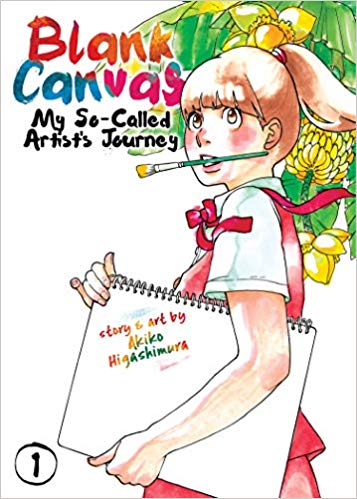By Akiko Higashimura. Released in Japan by Shueisha, serialized in the magazine Cocohana. Released in North America by Seven Seas. Translated by Jenny McKeon. Adapted by Ysabet MacFarlane.
The works of Akiko Higashimura have gotten incredibly popular in North America over the last few years, and of course in Japan she’s a top josei artist. Everyone knows Princess Jellyfish, and Tokyo Tatareba Girls is at least a cult hit. So it’s great to see a publisher pick up her autobiographical tale of how she became the artist she is today. And, as with many Japanese manga biographies, the story is filtered through telling us what a mess she was in high school, and how attempts to praise everything she did led her to have an inflated sense of herself. No one wants to read the story without struggle, after all. So Akiko has terrible grades, to the point where she can’t even pass the makeup tests. This wouldn’t bother her, because she thinks she can cruise into art school… but then she finds out just how far she has to go.
While other characters drift through here and there, mostly this is a story of three people. Akiko is the hapless art student with an immense ego; Futami is her best friend who, even in high school, has perfected the jaded seen-it-all snarker; and Kenzou-sensei is their art teacher, who teaches out in the middle of nowhere, seems to be constantly shouting and screaming, and hits his students with a kendo sword when they do things wrong – which is all the time. Akiko is absolutely horrified at this, but, after a brief attempt at giving up, keeps returning to the school. And it’s a good thing, too, as college is going to be rough. She doesn’t get a recommendation. She fails the Tokyo school that was her first choice. Is she really going to be able to realize her dream of being a shoujo manga artist?
Three’s a fun feel to this volume, even as you’re watching Akiko careen down her career path, hitting obstacles all along the way. I especially liked when she started to buy the “shady” test guides to help her study, the ones that teach you how to take tests rather than what’s actually on the test… and they helped her immensely, as that’s exactly the sort of learning she needed. As for Kenzou-sensei, he’s handled perfectly, with his seemingly violent nature balanced out by hidden (and not so hidden) acts of compassion. He’s clearly talented, and we see his “draw the same thing over and over and over till you have it memorized” teaching does start to have an effect on Akiko’s work. If there’s one thing that makes me wary, it’s that the narrative is making it thuddingly clear that this manga is going to end with his death; almost every chapter has a wistful, longing ending to it that kept making me think “OK, when’s he gonna die?”. Not at the end of this volume, and it’s five volumes long, so probably not for a while. But there’s an ominous feel to the whole thing.
If you’re interested in this author’s works, or just like seeing people struggling to make it, this is a great book to get. I’m definitely going to be reading more.

